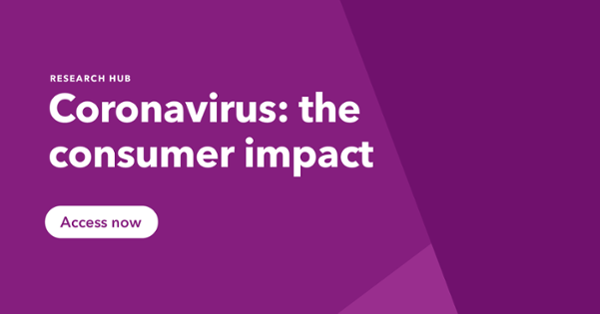Shifts in purchasing behaviors are standard for any country touched by the coronavirus pandemic; with adjustments in attitudes toward personal finances and nonessential buying being the first to budge.
All Brits and the majority of Americans are now experiencing some form of lockdown. Given that both nations have good ecommerce infrastructures and are currently among the top 10 most affected countries worldwide, trends in these parts can set a precedent for markets in earlier phases of the pandemic.
Our most recent study in the coronavirus series (conducted between April 2-6 and available on our hub) paints a picture of how the outbreak is affecting consumer sentiment and buying behaviors across both markets; while accounting for important demographic differences.
Grocery purchases are witnessing an uptick across various product categories.
Supermarket panic buying drove the number of transactions in the UK up massively a few weeks ago, with U.S. stockpiling devastating supermarket shelves up-and-down the country.
While this peak is proving to be short-lived, our survey indicates that consumers are continuing to buy certain items more than they would under usual circumstances.
50% in the U.S. and 43% in the UK have been spending more on their regular grocery shop since the start of the outbreak.
Cleaning products, toiletries and non-perishable goods are priority buys
% of internet users in the U.S./UK who say they have been purchasing more of the following
| U.S. | UK | |
| Household cleaning products (e.g. cleaning spray, bleach) | 53 | 29 |
| Personal hygiene products (e.g. hand wash) | 53 | 32 |
| Personal toiletries (e.g. toilet paper) | 48 | 27 |
| Shelf-stable products (e.g. pasta, rice, flour) | 48 | 33 |
| Fresh food/perishable items (e.g. dairy, eggs, meat, vegetables) | 43 | 30 |
| Canned vegetables/meats | 41 | 27 |
| Bottled water | 39 | 14 |
| Frozen vegetables/meats | 36 | 29 |
| Snack foods (e.g. pretzels, chocolate) | 35 | 30 |
| Other | 7 | 3 |
| I’m not purchasing more items | 13 | 29 |
Less security around individual finances might lead us to expect a drop in personal spending. For example, our latest wave of coronavirus research across 17 markets shows half of internet users in the UK are delaying making large purchases.
But what consumers are cutting from their nonessential shopping list, they’re making up for in essential purchases.
Although this trend appears in both markets, it’s more pronounced in the U.S., particularly when it comes to household cleaning and hygiene products.
In both countries, baby boomers (aged 57-64) lag behind in terms of buying most of the items listed above. But, while millennials (aged 24-37) and Gen X (aged 38-56) are at the front of this purchasing trend in the U.S., Gen Z (aged 16-23) are driving it most in the UK.
The effects of gender on buying habits are equally striking. Men are more likely than women to report an increase in purchasing products from 8 of the 10 item categories on our list in the U.S., and 7 in the UK.
This is influenced by men being significantly less likely to hold the main responsibility for the household shopping pre-outbreak.
These variations aside, there’s evidence of increased spending across all demographic brackets.
Attitudes toward grocery buying shed light on purchase increases.
With more internet users in these markets saying they sometimes struggle to make ends meet than believing they’re financially secure, one question we might ask is: what’s driving consumers to purchase more?
Grocery buyers are gravitating toward larger and less frequent shops.
Among those buying more items, when asked which statement best describes their current attitude toward grocery buying, topping the list in both countries is wanting to limit trips to the grocery store: 54% in the U.S. and 56% in the UK say this. This is followed by uncertainty about the availability of items (46% in the U.S. and 45% in the UK).
Being worried about running out of food and other essentials (often taking the media spotlight when accounting for the panic buying phenomena) is much higher in the U.S. (40%, compared to 29% in the UK) and among Gen Z (33%) – which clarifies some of the figures displayed in the chart above.
Consumers are advised to remain at home where possible and can often feel unsettled by the idea of venturing out to buy necessities. When coupled with fears about running out of essentials, this concern helps explain the sudden urge to stockpile.
These statements ultimately show that, while worries about a lack of food are influencing this trend, the top reason given in both countries among those buying more suggests a logical effort to follow government and expert advice.
Despite countless memes mocking the minority who participated in the initial waves of panic buying, our data indicates that increased spending on grocery shopping is widespread. By considering it from a consumer perspective, this research certainly provides further food for thought.



